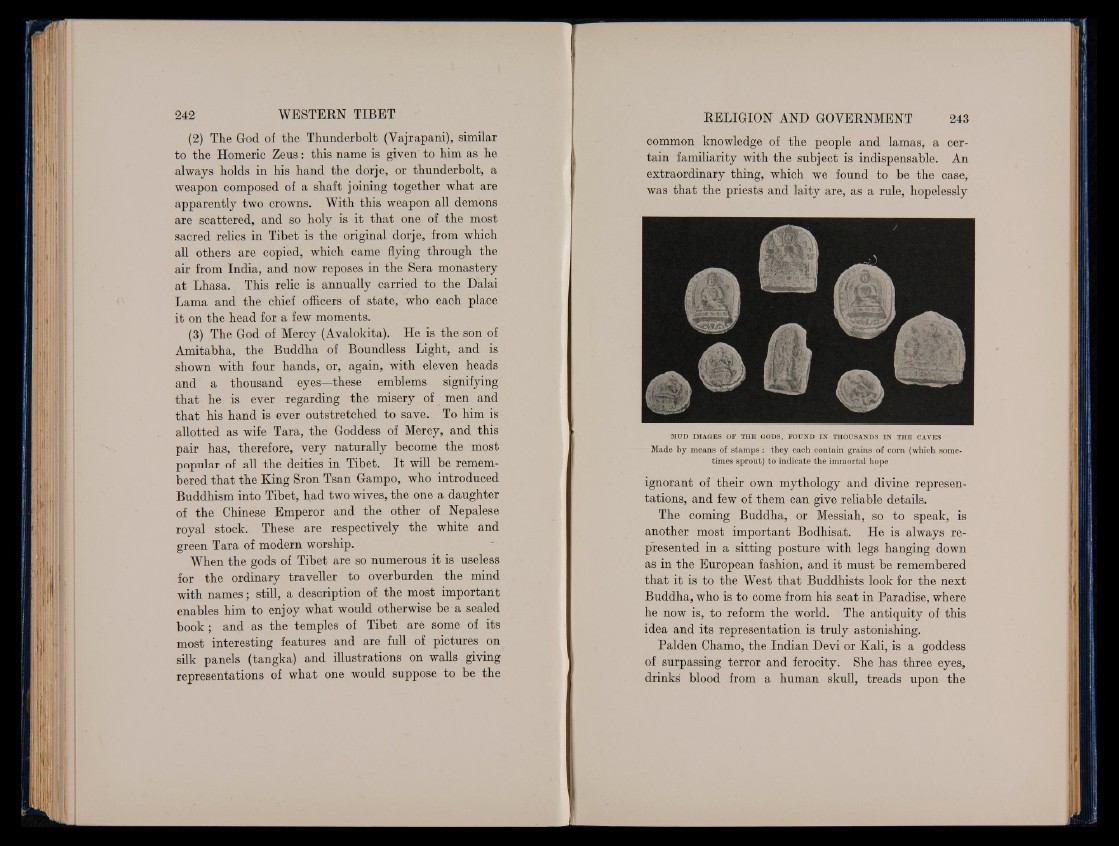
(2) The God of the Thunderbolt (Vajrapani), similar
to the Homeric Zeus: this name is given to him as he
always holds in his hand the dorje, or thunderbolt, a
weapon composed of a shaft joining together what are
apparently two crowns. With this weapon all demons
are scattered, and so holy is it that one of the most
sacred relics in Tibet is the original dorje, from which
all others are copied, which came flying through the
air from India, and now reposes in the Sera monastery
at Lhasa. This relic is annually carried to the Dalai
Lama and the chief officers of state, who each place
it on the head for a few moments.
(3) The God of Mercy (Avalokita). He is the son of
Amitabha, the Buddha of Boundless Light, and is
shown with four hands, or, again, with eleven heads
and a thousand eyes—these emblems signifying
that he is ever regarding the misery of men and
that his hand is ever outstretched to save. To him is
allotted as wife Tara, the Goddess of Mercy, and this
pair has, therefore, very naturally become the most
popular of all the deities in Tibet. I t will be remembered
that the King Sron Tsan Gampo, who introduced
Buddhism into Tibet, had two wives, the one a daughter
of the Chinese Emperor and the other of Nepalese
royal stock. These are respectively the white and
green Tara of modern worship.
When the gods of Tibet are so numerous it is useless
for the ordinary traveller to overburden the mind
with names; still, a description of the most important
enables him to enjoy what would otherwise be a sealed
book; and as the temples of Tibet are some of its
most interesting features and are full of pictures on
silk panels (tangka) and illustrations on walls giving
representations of what one would suppose to be the
common knowledge of the people and lamas, a certain
familiarity with the subject is indispensable. An
extraordinary thing, which we found to be the case,
was that the priests and laity are, as a rule, hopelessly
MUD IMAGES OF THE GODS, FOUND IN THOUSANDS IN THE CAVES
Made by means of stamps : they each contain grains of corn (which sometimes
sprout) to indicate the immortal hope
ignorant of their own mythology and divine representations,
and few of them can give reliable details.
The coming Buddha, or Messiah, so to speak, is
another most important Bodhisat. He is always represented
in a sitting posture with legs hanging down
as in the European fashion, and it must be remembered
that it is to the West that Buddhists look for the next
Buddha, who is to come from his seat in Paradise, where
he now is, to reform the world. The antiquity of this
idea and its representation is truly astonishing.
Palden Chamo, the Indian Devi or Kali, is a goddess
of surpassing terror and ferocity. She has three eyes,
drinks blood from a human skull, treads upon the